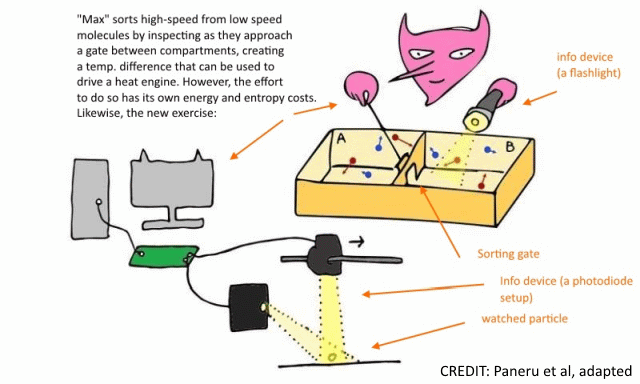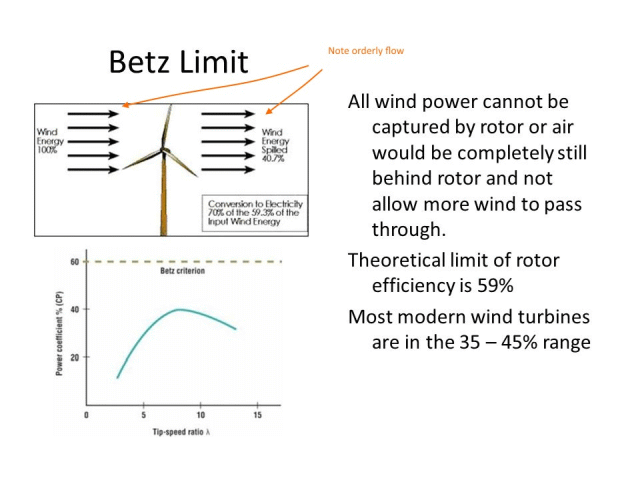Maxwell’s Demon (sometimes, “Max”) has long been a fictional device for discussing how if we have access to information we can manipulate molecular scale particles to extract work. Now, physics dot org is discussing a case:
>>Physicists have experimentally demonstrated an information engine—a device that converts information into work—with an efficiency that exceeds the conventional second law of thermodynamics. Instead, the engine’s efficiency is bounded by a recently proposed generalized second law of thermodynamics, and it is the first information engine to approach this new bound . . . . [R]ecent experimental demonstrations of information engines have raised the question of whether there is an upper bound on the efficiency with which an information engine can convert information into work. To address this question, researchers have recently derived a generalized second law of thermodynamics, which accounts for both energy and information being converted into work. However, no experimental information engine has approached the predicted bounds, until now.
The generalized second law of thermodynamics states that the work extracted from an information engine is limited by the sum of two components: the first is the free energy difference between the final and initial states (this is the sole limit placed on conventional engines by the conventional second law), and the other is the amount of available information (this part sets an upper bound on the extra work that can be extracted from information).
To achieve the maximum efficiency set by the generalized second law, the researchers in the new study designed and implemented an information engine made of a particle trapped by light at room temperature. Random thermal fluctuations cause the tiny particle to move slightly due to Brownian motion, and a photodiode tracks the particle’s changing position with a spatial accuracy of 1 nanometer. If the particle moves more than a certain distance away from its starting point in a certain direction, the light trap quickly shifts in the direction of the particle. This process repeats, so that over time the engine transports the particle in a desired direction simply by extracting work from the information it obtains from the system’s random thermal fluctuations (the free energy component here is zero, so it does not contribute to the work extracted).
One of the most important features of this system is its nearly instantaneous feedback response: the trap shifts in just a fraction of a millisecond, giving the particle no time to move further and dissipate energy. As a result, almost none of the energy gained by the shift is lost to heat, but rather nearly all of it is converted into work. By avoiding practically any information loss, the information-to-energy conversion of this process reaches approximately 98.5% of the bound set by the generalized second law. [Govind Paneru, Dong Yun Lee, Tsvi Tlusty, and Hyuk Kyu Pak. January 12, 2018. “Lossless Brownian Information Engine.” Physical Review Letters. DOI: 10.1103/PhysRevLett.120.020601]>>
Of course, it can be realised that to set up all of this capability to extract work from information has its own energy and entropy costs. And, in a sense, this is unsurprising, a windmill routinely extracts a high fraction of available energy up to the Betz limit, precisely because the wind is an orderly flow of fluid.
What is highly relevant is that this is an inadvertent confirmation of the relevance of information to thermodynamics and to entropy. All of this fits right in with the informational thermodynamics approach championed by Jaynes and others since. Indeed, Harry S Robertson in Statistical Thermophysics (Prentice, 1993) observed that: “the standard assertion that molecular chaos exists is nothing more than a poorly disguised admission of ignorance, or lack of detailed information about the dynamic state of a system . . . . If I am able to perceive order, I may be able to use it to extract work from the system, but if I am unaware of internal correlations, I cannot use them for macroscopic dynamical purposes. On this basis, I shall distinguish heat from work, and thermal energy from other forms . . . “ [pp. vii – viii.]
All of this then becomes highly relevant to the ID debates:
>>[T]he results may also lead to practical applications, which the researchers plan to investigate in the future.
“Both nanotechnology and living systems operate at scales where the interplay between thermal noise and information processing is significant,” Pak said. “One may think about engineered systems where information is used to control molecular processes and drive them in the right direction. One possibility is to create hybrids of biological systems and engineered ones, even in the living cell.”>>
Food for thought. END

